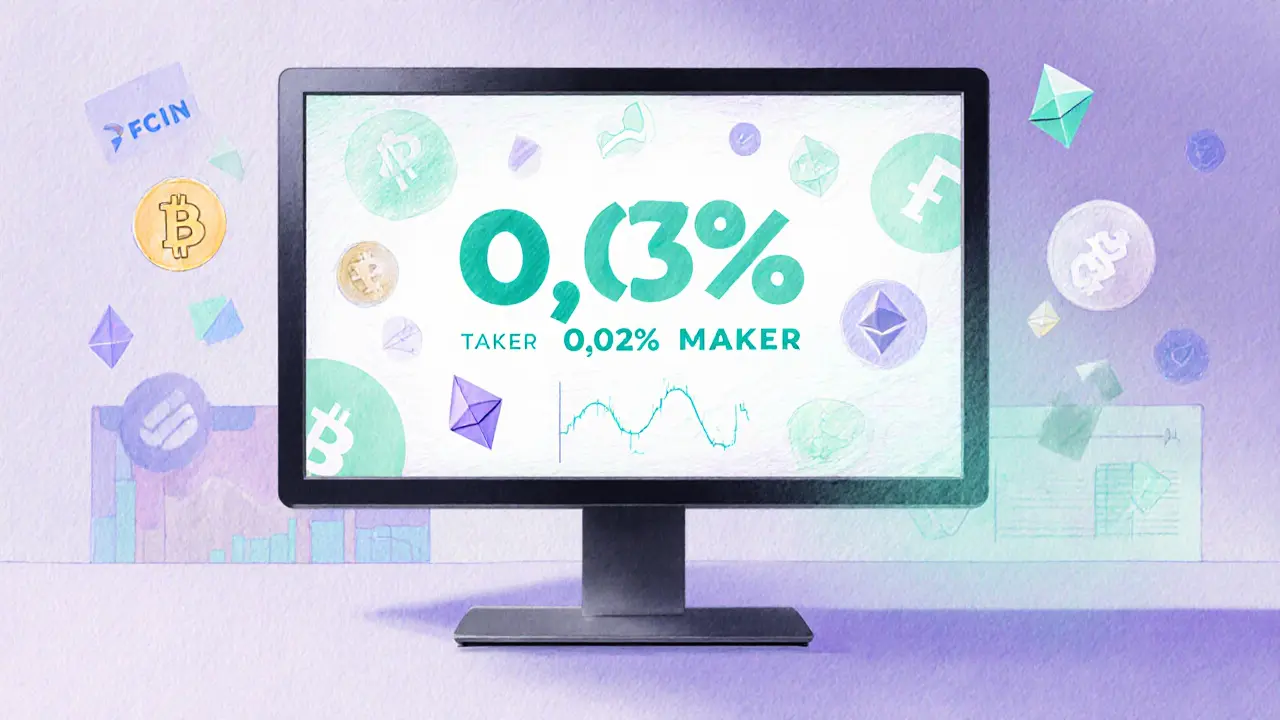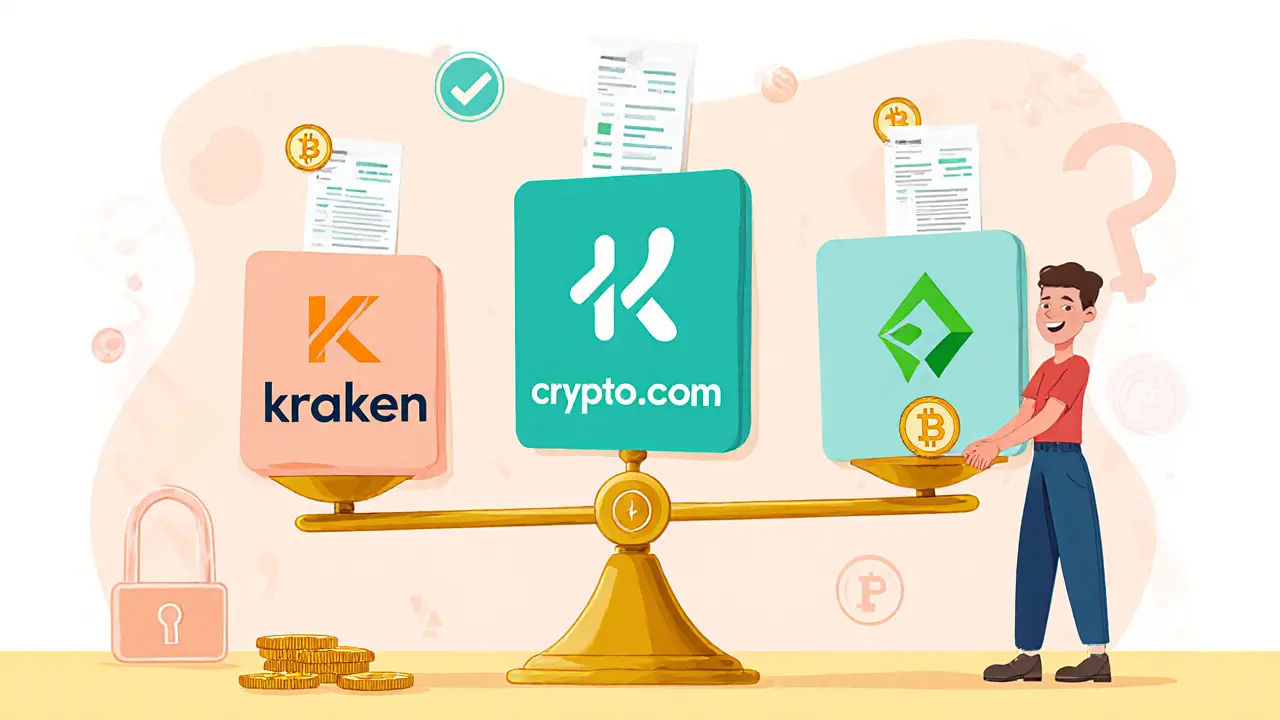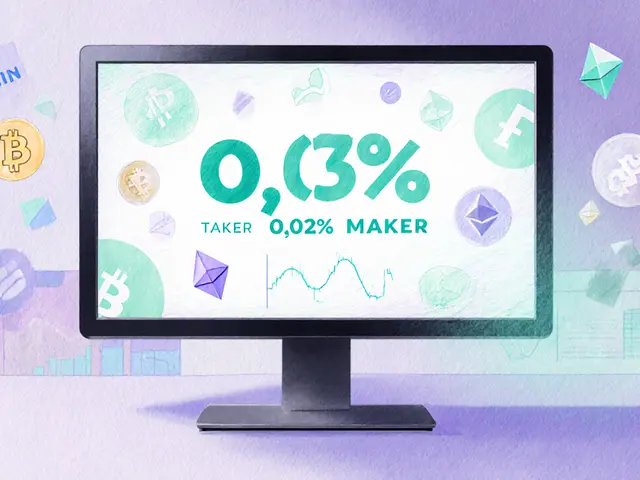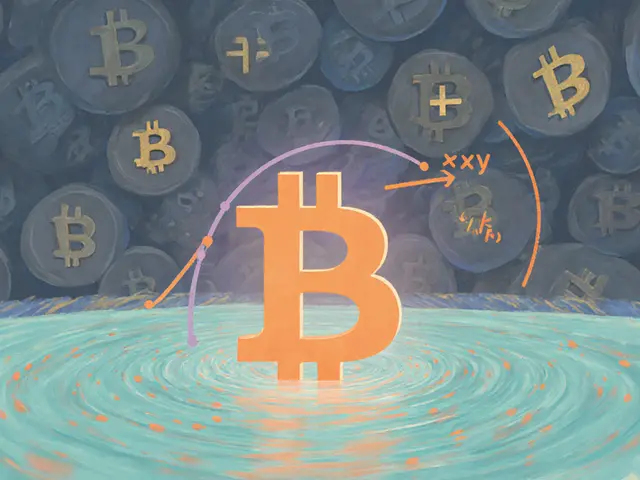FCoin Crypto Exchange Review: Fees, Safety, and Better Alternatives

FCoin Fee Calculator
Fee Comparison Results
Note: FCoin's fees are 0.03% taker and 0.029% maker. Other exchanges like Kraken, Coinbase, and Crypto.com offer competitive fees with additional benefits like fiat support, transparency, and security.
When you hear ‘ultra‑low fees’ you might think you’ve found a hidden gem. FCoin is a cryptocurrency exchange that marketed itself exactly that way, boasting taker fees of 0.03% and maker fees of 0.029%. On paper it sounds unbeatable, but does the platform hold up in 2025’s security‑first, regulation‑heavy market? Below you’ll find a straight‑talk review that cuts through the hype, weighs the real risks, and points you toward safer, still‑cheap options.
Key Takeaways
- FCoin’s maker‑taker fees are among the lowest ever recorded (0.03% taker, 0.029% maker).
- The exchange only supports crypto‑to‑crypto trades - no fiat on‑ramps, no direct USD deposits.
- Withdrawal fee details are vague, raising red flags for cost‑savvy traders.
- User sentiment is abysmal: a 1‑out‑of‑5 rating based on limited reviews.
- Established 2025 platforms like Kraken, Coinbase, and Crypto.com offer comparable or better fees plus security, compliance, and fiat support.
What Is FCoin?
FCoin launched as a crypto‑only exchange that tried to win traders by undercutting every other fee schedule. It operates on a maker‑taker fee model, meaning the side that adds liquidity (maker) pays slightly less than the side that takes liquidity (taker). The touted advantage was simple: you keep more of each trade.
However, the platform never added fiat gateways. New investors who only have a bank account cannot buy Bitcoin, Ether, or any other asset directly on FCoin. They must first acquire crypto on an exchange that accepts fiat, then move those coins into FCoin’s wallets. This extra step erodes the convenience factor that many newer traders look for.
Fee Structure in Detail
The headline numbers-0.03% for takers and 0.029% for makers-are indeed lower than the industry average, which hovers around 0.10%‑0.25% for most mid‑volume exchanges. To illustrate the impact, consider a $10,000 trade:
- At a 0.03% taker fee, you’d pay $3.
- At a typical 0.15% taker fee (e.g., Binance), the cost jumps to $15.
This difference matters for high‑frequency traders, but it’s a fraction of the overall cost picture when you factor in hidden withdrawal fees and the risk of moving assets between platforms.
User Experience & Rating
Consumer sentiment is a reliable sanity check. According to public review aggregators, FCoin sits at a dismal 1 out of 5 rating based on a single user review. While a solitary rating isn’t a statistical goldmine, the stark contrast to competitors-Kraken (4.8/5), Coinbase (4.5/5)-suggests a serious usability or trust issue.
Common complaints include slow customer support response times, confusing interface layouts, and the lack of transparent withdrawal charges. When a platform fails to address these basics, traders quickly lose confidence.

Operational Limitations
Beyond fees, two operational factors stand out:
- No fiat deposits. You must already own crypto to start trading, which eliminates a large beginner segment.
- Opaque withdrawal fees. The exchange’s website does not publish a clear schedule, forcing users to test withdrawals or dig through community forums for estimates.
Both issues increase the total cost of ownership. Even if the trading fee is minuscule, unexpected withdrawal fees can easily dwarf the savings.
Security and Regulatory Compliance
In 2025, security is the non‑negotiable baseline. Leading exchanges publish audit reports, engage third‑party penetration testers, and hold insurance funds for user assets. FCoin’s public disclosures on security are sparse. There is no evidence of a formal bug bounty program, and the platform does not hold any regulatory licenses in major jurisdictions such as the United States or the European Union.
For context, Kraken boasts an 11‑year hack‑free record, while Coinbase is regulated as a Money Services Business (MSB) and offers FDIC‑insured cash balances. Crypto.com provides a $10million insurance policy for custodial assets. FCoin lacks comparable certifications, which makes it a riskier choice for anyone holding sizable sums.
How FCoin Stacks Up Against 2025 Leaders
| Feature | FCoin | Kraken | Coinbase | Crypto.com |
|---|---|---|---|---|
| Trading Fees (taker) | 0.03% | 0.01%‑0.40% (volume‑based) | 0%‑3.99% (varies by product) | 0%‑0.20% (volume‑based) |
| Maker Fee | 0.029% | 0.00%‑0.40% | 0%‑3.99% | 0%‑0.20% |
| Fiat Support | No | Yes (USD, EUR, GBP) | Yes (USD, EUR, CAD, …) | Yes (USD, EUR, GBP, …) |
| Withdrawal Fee Transparency | Unclear | Published per coin | Published per coin | Published per coin |
| Security Track Record | Limited public data | 11‑year hack‑free | Regular audits, insurance | Insurance, SOC2 compliance |
| Regulatory Licenses | None disclosed | FINRA‑registered, EU licenses | NYDFS, FCA, etc. | FinCEN, EU, Singapore |
| User Rating (out of 5) | 1 (single review) | 4.8 | 4.5 | 4.6 |
The table makes it clear: FCoin wins on raw fee percentages but loses on every other dimension that matters to serious traders in 2025. If you need fiat on‑ramps, transparent fees, or a proven security record, the alternatives dominate.
Low‑Fee Alternatives Worth Considering
If ultra‑low fees are your primary goal, you don’t have to settle for a platform with hidden risks. Here are three exchanges that blend cheap trading with solid safety nets:
- Kraken - Offers 0.00% maker fees for high‑volume traders and a clear, tiered fee schedule. Strong security and full fiat support make it a safe low‑cost choice.
- Crypto.com - With its “Zero‑Fee” promotion on select pairs and a transparent withdrawal schedule, it rivals FCoin’s fees while providing insurance and regulatory coverage.
- Robinhood Crypto - Commission‑free trades for U.S. users, albeit limited coin selection. Ideal for beginners who value simplicity and cost.
All three publish withdrawal fees per coin, maintain robust customer service, and are regularly audited. The net cost difference versus FCoin is often negligible when you factor in the hidden costs of moving money in and out of a platform that hides its withdrawal charges.
Bottom Line: Is FCoin Worth Your Money?
FCoin’s ultra‑low maker‑taker fees make it an eye‑catcher, but the platform falls short where it matters most in 2025: security transparency, regulatory compliance, and fiat accessibility. The single poor user rating and vague withdrawal fees suggest you’d be better off on a more established exchange, even if you pay a few dollars more per trade.
For traders who already hold crypto and are looking for a niche, short‑term arbitrage window, FCoin could still serve a purpose. However, for most investors-especially those who value safety and ease of moving funds-Kraken, Crypto.com, or a commission‑free platform like Robinhood offers a more balanced mix of low fees, security, and user support.

Frequently Asked Questions
What are the exact trading fees on FCoin?
FCoin charges a taker fee of 0.03% and a maker fee of 0.029% per trade. These rates apply to all crypto‑to‑crypto pairs and do not change based on trading volume.
Can I deposit USD directly into FCoin?
No. FCoin only supports crypto deposits and withdrawals. To trade on FCoin you must first buy crypto on a fiat‑friendly exchange and then transfer it to FCoin.
Why are withdrawal fees important?
Even a tiny trading fee can be offset by a high withdrawal charge. If an exchange hides its withdrawal fees, you might pay $20‑$50 to move $500 of crypto, which erodes any savings from low‑fee trading.
How does FCoin compare to Kraken on security?
Kraken publishes annual security audits, operates a bug bounty program, and has never been hacked in its 11‑year history. FCoin provides no public security audit, no known insurance coverage, and limited information about its cold‑storage practices.
Is FCoin still operating in 2025?
The exchange’s public presence has dwindled, and many crypto‑news outlets no longer list FCoin among active U.S.‑friendly platforms. While the site may still be reachable, the lack of recent updates suggests limited operational activity.








Despite the hype, the 0.03% taker fee on FCoin is practically negligible when you factor in the hidden latency and the liquidity‑starved order books. In high‑frequency parlance, that’s a slippage risk that dwarfs any nominal fee savings 😂. The real cost is the exchange’s opaque withdrawal policy and the occasional token‑burn mechanism that can bite you on the back‑end. So, if you’re chasing micro‑margins, look elsewhere.
FCoin’s fee structure may look appealing on paper, but it’s essential to weigh it against the overall ecosystem. The platform’s security measures, such as two‑factor authentication and cold‑storage ratios, provide a solid baseline. New users should start with modest amounts and test the withdrawal process before scaling up. Patience and due diligence will pay off.
FCoin offers low taker fees but the real concern is the limited fiat on‑ramps the exchange provides. Users looking for direct USD deposits might find better options on larger platforms.
FCoin is a classic case of fee‑centred marketing masking weak compliance. The platform’s KYC is half‑hearted and the audit trails are non‑existent. Anyone serious about safety should steer clear.
Let’s be clear: African traders have been burned by FCoin’s sudden token swaps and opaque fee rebates. The exchange’s governance token lacks real utility, making it a speculative trap. Opt for regulated venues that respect regional regulations.
i’ve tried fcoin a couple times the UI feels smooth but the support response time is slow you might want to compare with kraken or binance for reliability
The soul of a crypto exchange is not measured in percentages alone. While FCoin boasts a sleek interface, the philosophical underpinning of trust lies in transparency. A fee, however low, cannot compensate for a lack of open ledger audits. In the grand tapestry of digital finance, choose the thread that weaves honesty into every transaction.
Low fees don’t equal low risk.
Both sides have valid points – FCoin’s fees are competitive, yet its custodial controls could improve. It’s worth keeping an eye on upcoming regulatory updates before making a final call.
Honestly, the fee whisper‑campaign feels like a thin veil over the platform’s shaky liquidity pool, which could trigger an avalanche of slippage during volatile swings. It’s a classic case of “look at the number, ignore the underlying risk”.
One might argue that FCoin’s fee model is a micro‑cosm of modern finance: it promises efficiency while hiding systemic fragilities behind glossy dashboards. The enlightened investor sees beyond the surface.
Don’t let the low fees intimidate you – dig into the security protocols! FCoin’s two‑factor authentication and encrypted cold wallets are solid, but you should also set withdrawal whitelists. Stay proactive.
🔥🚀 If you’re hunting for the best fee‑to‑service ratio, start by mapping out your trade volume. For under $10k monthly, FCoin might edge out Kraken, but once you cross that threshold, tiered discounts on larger platforms become more attractive. Keep the data in a spreadsheet and you’ll see the break‑even point clearly.
Quick tip: FCoin’s maker fee is slightly lower than its taker fee, so placing limit orders can shave off that extra 0.001%. It’s a small win, but those add up over time. Combine that with a disciplined risk strategy and you’ve got a solid trading game.
When evaluating any crypto exchange, the first metric that most traders glance at is the fee schedule, and FCoin’s 0.03% taker fee certainly looks tempting at first blush. However, a superficial glance can be deceiving, as the fee is only one piece of a much larger puzzle that includes security, liquidity, regulatory compliance, and user experience. The platform’s security architecture employs standard two‑factor authentication and cold storage, yet it lacks the robust insurance funds that some larger exchanges provide to cover potential breaches. Liquidity is another cornerstone; FCoin’s order book depth often thins out during periods of high volatility, leading to slippage that can erode the nominal fee savings. Moreover, the exchange’s customer support response times have been reported as inconsistent, which can become a critical bottleneck when urgent withdrawals are needed. On the regulatory front, FCoin operates without a clear licensing framework in many jurisdictions, leaving users exposed to legal ambiguities. The fee calculator featured on the site is a useful tool, but it assumes ideal market conditions that rarely exist in practice. Users should also be aware of the token‑burn mechanism embedded in the platform’s native token, which can affect overall asset value. When comparing alternatives, exchanges like Kraken and Coinbase not only offer competitive tiered fee structures but also provide fiat on‑ramps, insurance coverage, and transparent audit reports. These additional services often justify a slightly higher fee for many traders who prioritize safety over marginal cost reductions. In the end, the decision hinges on your personal risk tolerance, trading frequency, and the importance you place on ancillary services. If you trade low volumes and are comfortable navigating occasional liquidity gaps, FCoin’s fee advantage might be worthwhile. Conversely, if you require consistent depth, rapid support, and regulatory certainty, seeking a more established platform could be the smarter move. Ultimately, a holistic assessment that weighs all these factors will lead to a more informed choice.
It would be a grave misapprehension to conflate the modest fee percentages offered by FCoin with a comprehensive assessment of institutional-grade custodial safeguards. The paucity of transparent audit trails engenders a latent risk that cannot be ignored.
Hey folks, if you’re just getting started, play around with the fee calculator, but also set up a separate cold wallet for long‑term holdings. It’s a simple habit that saves headaches later.
👍 The fee stats are neat, yet remember that withdrawal limits and verification levels can add hidden costs. Keep those in mind when you budget your trades.
While FCoin’s fee model appears attractive, a prudent approach involves testing the platform with a small deposit, monitoring the withdrawal process, and then scaling up if the experience meets expectations.
🤷♂️ Low fees? Sure, but the UI feels clunky and the charting tools are basic. Not worth the hassle for serious traders.
From a regulatory standpoint, FCoin’s lack of a clear operating license in major jurisdictions raises significant compliance concerns. Investors should demand full disclosure before committing capital.
Honestly, the platform’s “low fees” slogan is a shallow veneer that masks its underlying fragility. Stay away unless you thrive on uncertainty.
Don’t let the fee debate discourage you; explore multiple exchanges, compare their features, and choose the one that aligns with your trading strategy.
Wow, another fee‑comparison article. Because we totally needed a spreadsheet to tell us that 0.03% is “low”. Next, we’ll get a guide on how to count to ten.